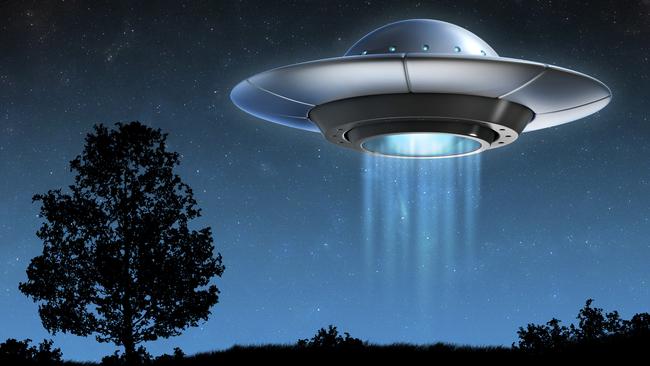Science Asks: Is There Anyone Out There? Little green men, tall tales
Jim Al-Khalili looks beyond the what, where and when of ET-hunting to the biggest conundrum of all: why bother?

The good news is that 80 light years away from Earth and counting, the feeble remains of what was once a television signal mark the frontier of humanity’s great scream into the cosmos. The bad news is that it may well be footage of Hitler opening the 1936 Olympics. But who is there to see it anyway?
Jim Al-Khalili, an Iraqi-born British theoretical physicist and broadcaster, has gathered a useful cross-section of the brightest minds in space science to answer this question. Aliens does a very good job of it. Al-Khalili’s book goes far beyond the what and the where and the when of extraterrestrial-hunting to the biggest conundrum of all: why bother?
Let’s start with the science. In 1900 the Prix Pierre Guzman held out 100,000 francs to the first person to make contact with life on another planet. Mars didn’t count because it was considered too easy. At least they had clarity then, even if it was the clarity of ignorance.
Today we have no idea what to expect. Or rather, we have so many ideas that we hardly know what to do with them.
Half a century ago Frank Drake, an American astronomer, devised an equation for working out how many other radio-communicating civilisations might be dotted across the Milky Way. It says a good deal about how far we have come since then that the plausible answers range from 0.000000000091 to 160 million.
Aliens does not duck this uncertainty.
“There are no alien civilisations,” writes Matthew Cobb, a zoologist from the University of Manchester. Take the odds of life emerging out of nothing, he says, multiply them by the odds of it finding a way to make enough energy to grow bigger than a single cell, then multiply that by the odds of it becoming in some way conscious of itself, and then once again by the odds of it inventing TV, and you have an extremely small number that may as well be zero.
At the other end of the spectrum stands Nick Lane, the evolutionary British biochemist who made his name with his book The Vital Question, arguing that wherever there is rock, water and carbon dioxide — i.e., basically everywhere — you have a good shot at life. Somewhere in the middle is Sara Seager, a US-Canadian Massachusetts Institute of Technology astrophysicist, who has customised the Drake equation to show that if we are very, very lucky our space telescopes might just detect a single alien life form from the imprint of its chemistry on the light from a distant star.
Or perhaps it will be a robot. Martin Rees, the Astronomer Royal, notes that the window between a society developing spaceworthy technology and that same society blowing itself to botheration is probably so brief that the first alien intelligence we meet is likely to be artificial. Or incomprehensible.
“Even if intelligence were widespread in the cosmos,” Rees remarks in an essay that would be downright bleak if anybody else had written it, “we may only ever recognise a small and atypical fraction of it. Some ‘brains’ may package reality in a fashion that we can’t conceive. Others could be living contemplative energy-conserving lives, doing nothing to reveal their presence.”
If you lower your standards and drop the requirement for extraterrestrial life to be bright enough to operate a toaster, the prospects improve. Mars remains the best bet. Its childhood was remarkably similar to Earth’s until pitiless winds from the sun stripped away the red planet’s atmosphere. The temperatures may fall as low as minus 153C and the ground may be ceaselessly battered by mutagenic cosmic rays, but it is plausible that single-celled organisms may have survived somewhere beneath the crust on a diet of stones.
Enceladus, a satellite of Saturn, and Europa, one of Jupiter’s moons, look as though they harbour promisingly warm oceans beneath their frozen exteriors. The true wildcard, though, is Titan. This grim parody of Earth, another moon of Saturn, is the only other place in the solar system where we have seen stable liquid at the surface. Sadly that liquid is a reservoir of methane cold enough to make bananas as fragile as porcelain. Still, life could be brooding in its depths at the sort of funereal pace normally associated with Dostoevsky novels.
This book is always lucid and sometimes unexpectedly beautiful. If it contradicts itself, it is because it contains multitudes. It is at its sharpest when it talks about the people who spend their lives waiting for a sign from the heavens, and at its most interesting when it discusses the planet beneath our feet.
The whole idea of the flying saucer, for example, was based on a mistake. An amateur pilot called Kenneth Arnold was passing over Washington State one day in 1947 when he saw a chain of nine aircraft skimming along at about 1900km/h. He was quoted by the local paper as saying they seemed “saucer-like” and were shaped like discs. All he’d meant, he said later, was that they flew “in a saucer-like fashion”. No matter. The meme was planted.
In the seven decades since Arnold’s sighting, thousands of people — most of them seemingly rural Americans — have been haunted by variations on hovering crockery peopled with slender green men. According to one infamously wonky 1992 report, 2 per cent of US citizens have been abducted by aliens. That was about five million people at the time.
Just imagine if it were true. Picture the tens of thousands of flying saucers, with the whole galaxy at their mercy, choosing instead to troll over Iowa or Nebraska every night on a cosmic kerb-crawl for lonely truckers.
You have to wonder what the discovery of real aliens would do. What does it say about us that we have spent billions straining our ears across the galaxy for the quietest echo of another mind? And what would happen if we heard it? Perhaps we are looking in all the wrong places. One by one, almost every essay in this book comes back to the inconceivably precious and strange and fragile world at our backs. And rightly so: the real lesson is that the aliens are already here.
Oliver Moody is a science journalist.
THE TIMES
Aliens — Science Asks: Is There Anyone Out There?
Edited by Jim Al-Khalili
Profile, 240pp, $19.95


